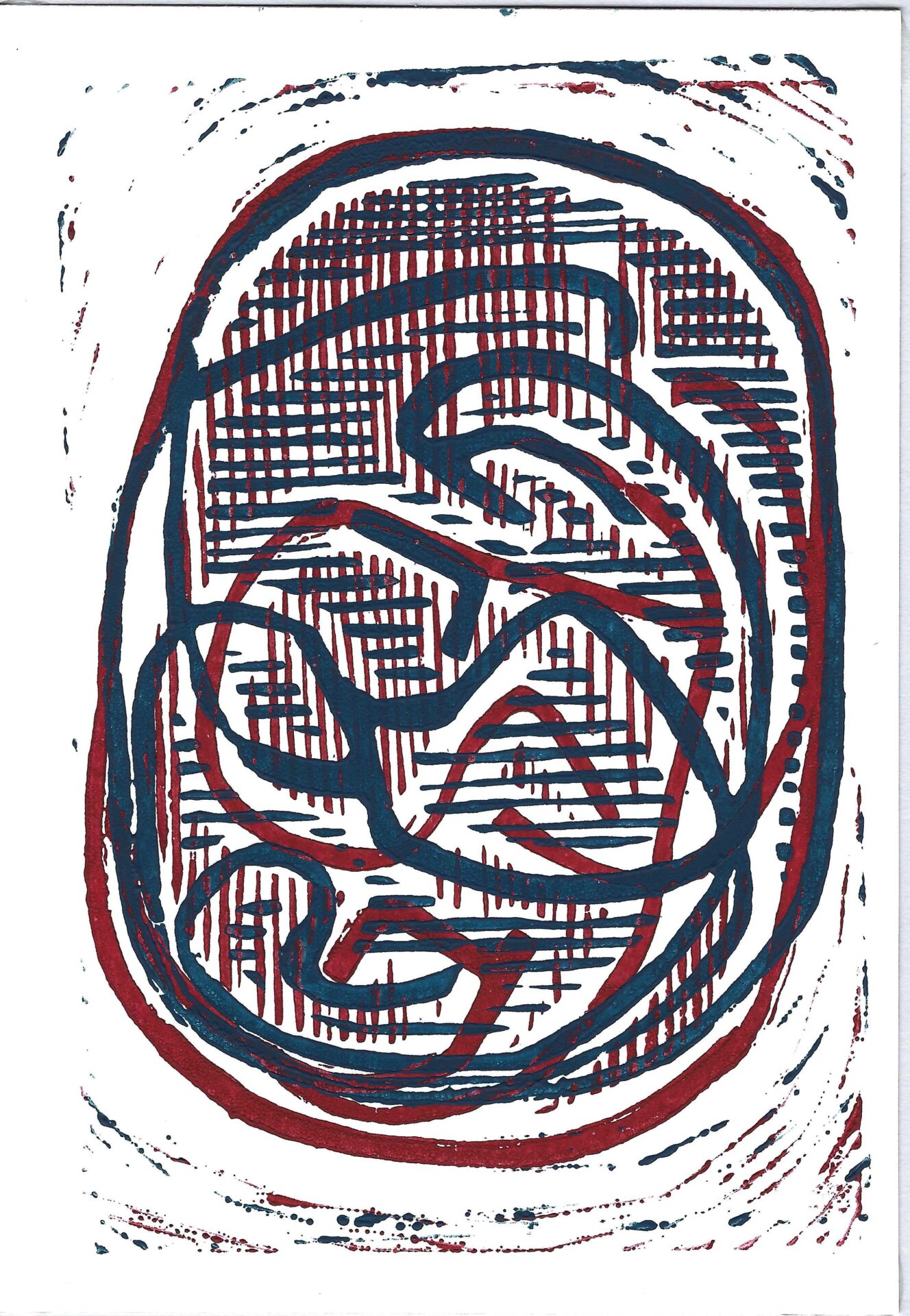If she had not been murdered by the Nazis in early March 1945, Anne Frank would turn 80 years old on 12 June 2009.
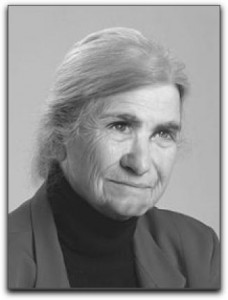
Anne Frank in an age progression image at 80 years old
What would you say to Anne Frank if you were to meet her on the street? …that she transformed your life? She made you a better, more hopeful person?
In 1944 she wrote these, seemingly contradictory sentences:
I still believe, in spite of everything, that people are truly good at heart
Then 2 sentences later:
I see the world being slowly transformed into a wilderness, I hear the approaching thunder that, one day, will destroy us too, I feel the suffering of millions…. In the meantime, I must hold on to my ideals. Perhaps the day will come when I’ll be able to realize them.
Do you think that what she experienced in the last few months of her life might have changed her outlook? Or perhaps might the ensuing 64 years have caused her to reevaluate her “belief”? We cannot know.
Is Anne Frank truly dead?
Whenever we die, we are remembered as never being, or becoming, any older that we were at our death. We cease to grow and change. And so it is with Anne Frank. She remains the young precocious teenager.
And yet, during the past 64 years much has happened that many consider both encouraging and discouraging.
She has become a metaphoric touchstone for who our better selves should be.
In her 1997 article in The New Yorker, “Who Owns Anne Frank” Cynthia Ozick took a close look at what had almost become an Anne Frank “industry” and attempts to “update” her message and understand it in our contemporary contexts. While stating at the outset that Anne Frank would by now be a world-class writer because:
At thirteen, she felt her power; at fifteen, she was in command of it.
Ozick shies away from imagining what she would be like:
Yet any projection of Anne Frank as a contemporary figure is an unholy speculation; it tampers with history, with reality, with deadly truth.
After all…
…the diary in itself… cannot count as Anne Frank’s story. …the end is missing.
[It] has been bowdlerized distorted, transmuted, traduced, reduced; it has been infantilized, Americanized, homogenized, sentimentalized; falsified, kitschified, and, in fact, blatantly and arrogantly denied.
Anne Frank’s story, truthfully told, is unredeemed and unredeemable.
And at the same time Ozick is concerned because of something Alvin Rosenfeld has reported in his essay “Popularization and Memory” (not available online), (she shares):
Anne Frank has become a ready-at-hand formula for easy forgiveness.
That she…
…remains in all countries a revered and comforting [emphasis mine] figure in the contemporary mind.
This seems to be a description of the grandmother we see in the photograph above.
Nobody, or, everybody owns Anne Frank
Anne Frank has entered the realm of mythic culture hero as have so many other people. The actual person lives on in the imaginations of all those who have encountered a tiny portion of her. These people (“We”) have, to add another metaphor, caught the ball and we’re running with it toward whatever goal posts we imagine are before us.
This process is not new. It began as soon as Anne’s (yes, she and I are on a first-name basis) diary was published in modified form by her father. Then picked up by Meyer Levin and transformed by Lillian Hellman (for Broadway then Hollywood), the “Dairy of a Young Girl” has been read by nearly every young literate teenager since the mid 1950s. Her image is nearly recognized even today.
Could Anne Frank grow older?
Another person who tried to introduce us to a different (an “older”) Anne Frank is Philip Roth in his 1979 novel The Ghost Writer. For some, unknown reason (perhaps because Roth’s conceit is too outlandish for her?) Ozick does not mention Roth in her article. In the novel, Roth’s literary stand-in Nathan Zuckerman falls in love with and wants to marry a woman who he believes is Anne Frank. An Anne Frank who has miraculously survived the Shoa. Various reasons have been offered as to why “Roth” would want to marry Anne Frank, among them an attempt to assuage his (presumed) Jewish guilt for having written novels that describe American Jewish life in highly critical images. Roth’s romantic concerns are not the issue here. Rather, the idea that he could “appropriate” Anne Frank at all. But appropriating real situations and people is what creative writers (including Cynthia Ozick, though she may fictionalize names) do.
So, is Anne Frank alive?
You might think that is a silly question, and yet Barbro Karlen believes she is. In fact Barbro believes she is Anne Frank!
In her fictionalized account of her “self-discovery” as Anne Frank And the Wolves Howled , Fragments of Two Lifetimes, Ms Karlen, born to non-Jewish parents in 1954 in Goetenborg, Sweden, believes that she is Anne Frank reincarnate. That would make the woman in the photograph at the top 24 years too old.
The fact that Anne Frank has had an impact on the world, especially young European non-Jewish women, causing some of them to decide to become (“reborn”) as Jews, is not unknown. And, indeed, Rabbi Yonassan Gershom (who seems to have written his own Wikipedia entry) has written extensively on the question of Reincarnation and the Holocaust. However Ms. Karlen has taken this to a new level.
Otto Frank, Anne’s father tried to get American visas for his family… had he succeeded she might now be living on Long Island. His efforts were thwarted, it seems because of underlying anti-Semitism in American society, by bureaucratic inertia, and a wartime fear of German-born immigrants. In an ex-post-facto attempt to remedy the situation, Christopher Bodkin of Sayville, LI attempted to acquire for Anne posthumous citizenship.
Will you meet Anne on the street?
Indeed, Anne is on the streets of New York City, though not as you might expect or appreciate.
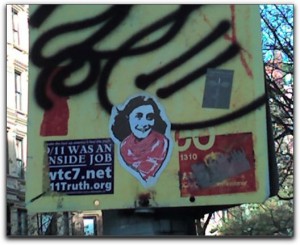
Anne Frank on the Upper West Side of Manhattan
Who “owns” Anne Frank? Indeed! And, why is she wearing a keffiyeh? It appears as if the person or group that posted that sticker (there must be more!) believes that Anne Frank would identify with the Palestinians and oppose Israel (or at least certain Israeli policies).
On April 17, 2009, The New York Times wrote a story about the chestnut tree that gave Anne Frank solace. The ailing tree has produced ten saplings that will be planted around the world, at least one of them in New York City.
Ten saplings that originated from that stately but seriously ailing tree are to be brought here later this year for distribution by the center [The Anne Frank Center, USA], a nonprofit organization with an office on the fifth floor of 38 Crosby Street.
38 Crosby Street?! That is around the corner from where my sister lived for nearly 30 years. Who knew? Why does this seem to be a secret? I decided I needed to visit. Attempting to take my photo at the entrance to the building and and not having as much success as I wanted, I asked a young man and woman in their thirties standing nearby smoking cigarettes (!) if they would help. They wondered why I wanted the photo and I told them that it was the entrance to the Anne Frank Center. They each had read the diary and were glad to know that the Center was there. The building has no identifying markers other than the little label (fourth from the top beneath the security camera) that reads “Anne Frank Center”.

visiting the Anne Frank Center USA in SoHo
It is as though zombie Annes walk the streets and true Anne is still in hiding!
Stay Vocal
Anne Frank appears on at least two different lapel buttons. One, which I was not able to acquire display’s the official line.
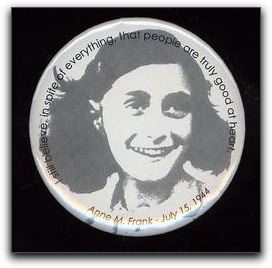
Anne Frank… still believes
The other, which I have been wearing for the few weeks leading up to this date and appears in the photo of me above, pushes the meaning of Anne Frank in a slightly different direction. It seems that the group Stay Vocal believes that if we each speak out about abuses we encounter, societal crises such as those that lead to Anne Frank’s murder would not occur.
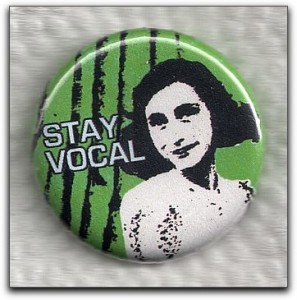
Anne Frank Stay Vocal
| Date: | 2008? |
| Size: | 2.54 |
| Pin Form: | straight clasp |
| Print Method: | celluloid |
| Text | STAY VOCAL |

